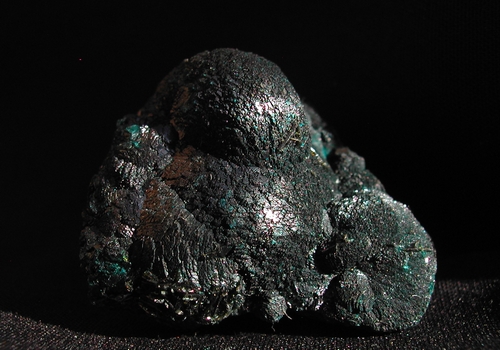|
|
|||||||||
|
|
 |
|
William Phillips in his book 'An Elementary Introduction to the knowledge of Mineralogy' third edition published in 1823 gave the following account of what he called Oblique Prismatic Arseniate of Copper, now known as Clinoclase. OBLIQUE PRISMATIC ARSENIATE OF COPPER Trihedral arseniate, Bournon. Cuivre arseniate prismatique triangulaire H. Trihedral Oliven-ore J. This variety is externally of a bluish black passing into a deep black, with a shining lustre: it occurs, though rarely, in extremely minute crystals, which may readily be mistaken for acute rhomboids, of which the acute terminations are sometimes replaced by triangular planes; these crystals however are in fact oblique rhombic prisms, of which the lateral planes meet alternately at angles of about 560 and 1240, and of which the oblique terminal plane declines from one acute angle to the other: the crystals are frequently fasciculated in a somewhat radiating position, so that only the terminal planes of the following figures are distinctly visible, sometimes however these planes are irregularly quadrilateral, owing to the presence of the modifying planes. It also occurs in curved lamellar concretions, which are nearly black externally. The minute crystals are often transparent and of a very beautiful blue or greenish blue colour, by transmitted light; the larger crystals are sometimes black and opaque, but on being scratched or scraped by the knife, are found to be internally of a blue colour. It is somewhat harder than calcareous spar. Specific gravity 4.2. It consists of 54 oxide of copper, 30 of arsenic acid, and 16 of water. Chenevix. Before the blow-pipe it flows like water, and in cooling crystallizes in small rhombic plates of a brown colour. It was found, though not very abundantly, with the preceding and succeeding varieties [Liroconite, Chalcophyllite and Olivenite] in the veins of Huel Muttrell, Huel Gorland, and Huel Unity in Cornwall. |
 |
||
|
Clinoclase labelled 'Aphanese' - Huel Gorland, Gwennap, Cornwall, UK AA Damour collection ex. Dr F Krantz Dark blue-black lustrous crystalline balls of Clinoclase |
||
|
J.H.Collins in his book 'A Handbook to the Mineralogy of Cornwall and Devon' published in 1871 gave the following description of Clinoclase [Klinoclase, Clinoclasite. Oblique Prismatic Arseniate of Copper.] Oblique; in small crystals; with a perfect cleavage parallel to O, more commonly in wedge-shaped or hemispherical aggregates, with curved cleavage; and radiated, fibrous, or columnar structure; brittle; translucent to opaque; lustre vitreous, pearly, or resinous; dark green or dark blue; streak bluish-green; H. 2.5-3; G. 4.2-4.4 B., etc. Altogether like Olivenite, which see. Comp. Hydrated arseniate of copper, as appears from the following analyses….. Loc. Ting Tang; Huel Unity; Huel Muttrell; Huel Gorland, and other mines near St. Day, formerly; Providence Mine, Lelant; and more recently at Bedford United Mines, near Tavistock, in hemispherical masses of a pure dark bluish-green colour; also found in Germany. Obs. It may be distinguished from Chalcophyllite by its higher specific gravity and darker colour, as also by its deflagration on charcoal (Chalcophyllite fuses quietly); from Torbenite it may be distinguished by its different blowpipe reactions and darker colour. The crystals may always be recognised by their form. Allan observes, "The crystals usually present a very dark blue colour and brilliant lustre," and "are easily recognisable, being aggregated in divergent groups, or disposed in extremely minute individuals in cavities in quartz." |
|
Copyright (C) 2003-2008 David Aubrey-Jones. All rights reserved. No part of this Web site and its contents may be reproduced in any form without the written permission of the author. |
|
[Liroconite] [Rarity] [Discovery] [Habit & Form] [Descriptions] [Locations] [Cornish Minerals] [Links] [About us] |